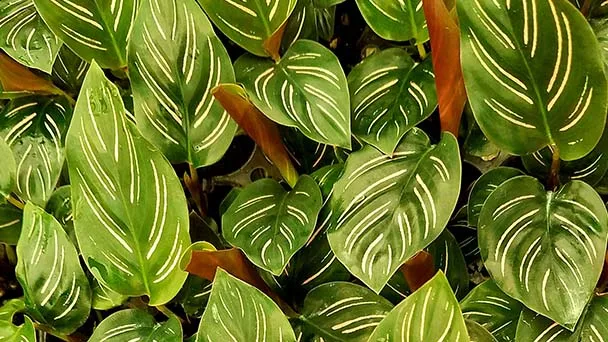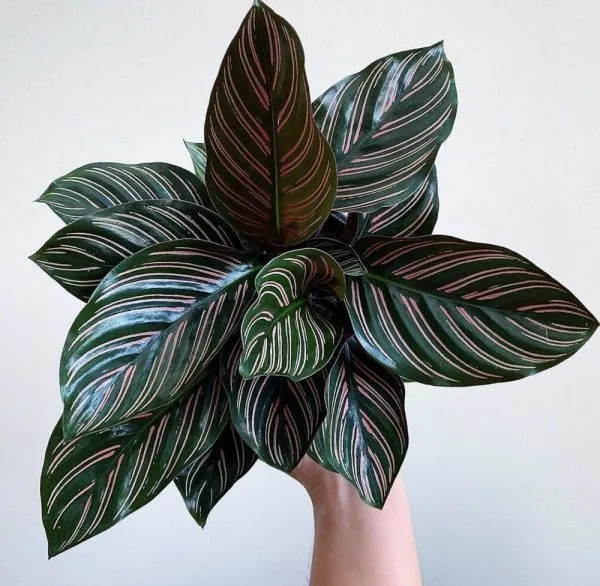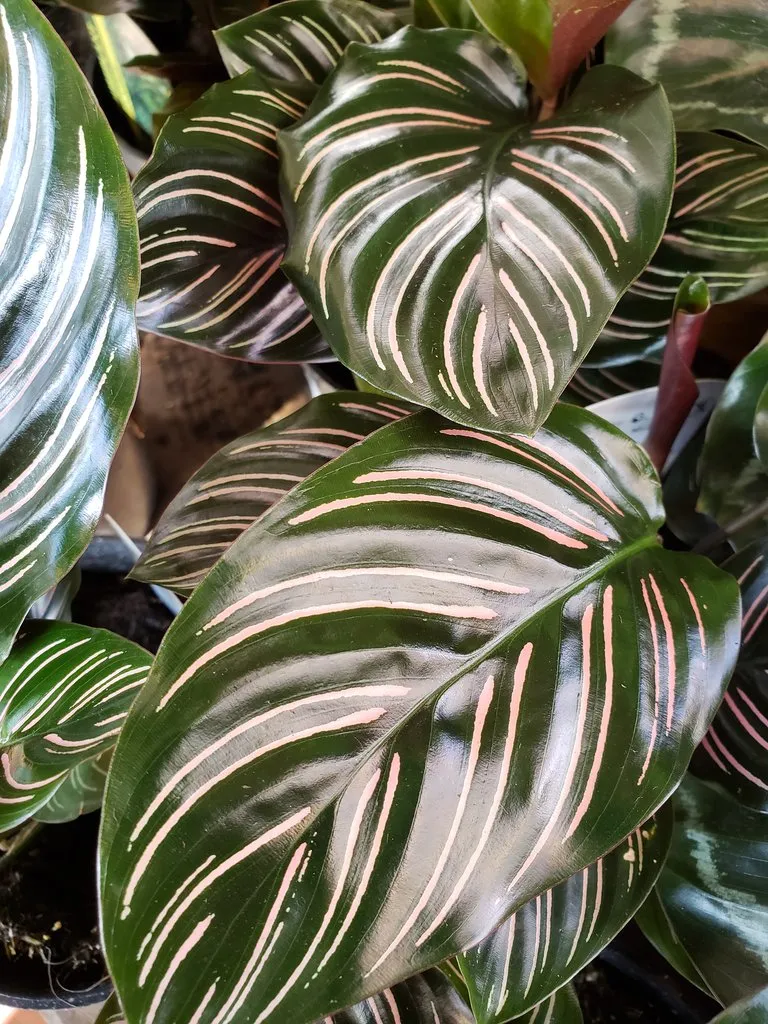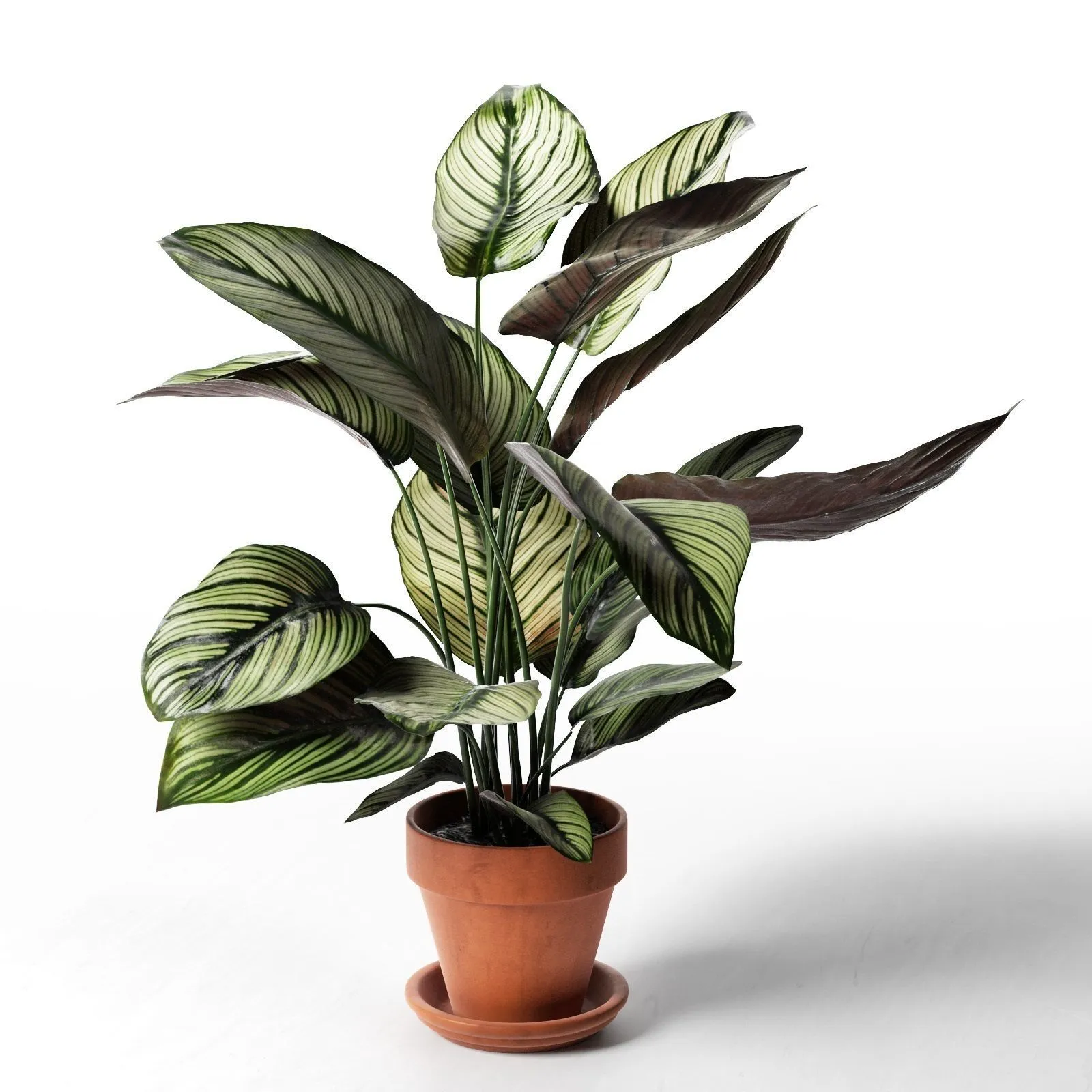Calathea Ornata (Variously Striped) Indoors Grow and Care
Written by Ivy
Nov 22 2021

Calathea Ornata (Variously Striped) is a perennial evergreen herb and we can grow and care for Calathea Ornata indoors. Calathea Ornata is strong and upright; The leaves are oval, bright green on the growing leaf surface and purplish red on the back. The young leaves have beautiful rose red or pink stripes, gradually turn white and disappear after maturity; Inflorescence spike ovate; Calathea Ornata love to grow in high temperature, wet and semi cloudy environments. It also has been introduced from China to South America, Africa, Oceania and Indonesia.


Before Calathea ornata is planted into a new flower pot, we can disperse the soil under the soil ball slightly to minimize the damage to the root system, so as to facilitate the combination of root system and new soil;
The new soil in Calathea ornata repotting shall be similar to the old soil as much as possible, so that the root system can better extend into the new soil and end the basin service as soon as possible. After the completion of Calathea ornata repotting, we shall pour water once, and place the potted plants in a cool and ventilated place for pot curing.
There are white and light green spots on the leaves of Calathea ornata. In the early stage of leaf spot disease, you can't see anything without careful observation. However, with the spread of bacteria, there will be a lot of yellowish brown near circular spots on the leaves, which will be gradually linked together with halos around. In the later stage, the disease spot expands, and the whole leaf will turn yellow and wither.
The occurrence of the Calathea Ornata disease is mainly related to the environment. The environment is high temperature and humidity, the air is not circulating, the planting density of plants is too large, or there are more weeds and rotten leaves in potted plants, or there is heavy fertilization and more nitrogen fertilizer.
After we found Calathea Ornata leaf spot, in order to reduce the occurrence of the disease, we should remove all the diseased branches and spray relevant drugs. We can choose to spray 38% oxacillin copper 800-1000 times or 4% fluorosilazole 1000 times every other week for three consecutive times.
We need to pull up the plant when the pot soil is half dry and half wet, remove the old soil, expose its roots, break off the tillers at the bottom of the rhizome, or cut it. When changing pots in Calathea ornata, we must pay attention to that the roots of Calathea ornata are very fragile, and we must cut them carefully. Avoid damaging the root, otherwise it will have more negative effects on its recovery and growth in the future.
We can cut the strong tillers at the bottom of Calathea ornata with a sharp knife and dry the wound slightly. We can apply some rooting powder to keep the soil slightly moist and maintain high air humidity. We can provide soft light in the morning or keep it in a ventilated and transparent place for about 3 ~ 4 weeks, These tillers of calathea ornata propagation from division can resume growth.
The leaves of Calathea ornata are the preferred material for many flower lovers. Many flower cutting lovers like to decorate vases or bouquets with the leaves of Calathea ornata to set off other plants. The leaves of Calathea Ornata are green stripes on the front, with good smoothness, and purple on the back. Moreover, the management method is simple and the survival time is long.
The leaves of Calathea ornata are peculiar, large and beautiful, and have excellent ornamental effect. They can live healthily in places without light, and can adapt to some environments. Therefore, it is suitable for planting and appreciation in courtyards, on both sides of urban roads, flower beds and other places. At the same time, it can also match with other plants. The north can be viewed indoors, which is also a good decoration material.
Calathea Ornata Quick InfoCalathea Ornata Care in DetailCalathea Ornata WateringCalathea Ornata SoilCalathea Ornata LightCalathea Ornata TemperatureCalathea Ornata HumidityCalathea Ornata FertilizerCalathea Ornata PruningCalathea Ornata RepottingCalathea Ornata Pest & Disease ControlCalathea Ornata PropagationCalathea Ornata Propagation from CuttingCalathea Ornata Propagation from DivisionCalathea Ornata Benefits
Calathea Ornata Quick Info
| Botanical/Scientific Name | Calathea Ornata |
| Common Name | Variously Striped, Pin-stripe, Pin-stripe Calathea |
| When to Grow/Bloom/Harvest | Plant between the months of March to October/Bloom during spring, summer and fall |
| Uses | Indoor office decoration purposes |
| Origin | South America |
| Light Care | Bright indirect light |
| Soil Care | Peat-based soil |
| Temperature Care | Between 65 - 75°F |
| Humidity Care | A humidity level of 50 percent or more |
| Watering | Every week or every two weeks |
| Pruning Care | Pruning Older Leaves |
| Fertilizer Care | A regular houseplant fertilize |
| Propagation | Propagated by division |
| Toxic | Non-toxic to cats and dogs |
| Flower Color | Orange flowers |

Calathea Ornata Care in Detail
Calathea Ornata Watering
We needs to provide Calathea Ornata with sufficient water. Generally, we need to water the soil every 2-3 days in spring, but drainage measures need to be taken in rainy days. In summer, when the temperature is high, we need to water the basin soil in the morning and evening. When the temperature is too high, we need to sprinkle water on the leaves. In autumn, we need to gradually reduce the amount of water, which can be watered every 2-5 days, In winter, water the soil evenly once every 10 days.Calathea Ornata Soil
We should select the soil suitable for the growth of Calathea Ornata during cultivation and propagation. It is best to use loose and nutritious acid soil, and the drainage of the soil should be good enough. If the soil of Calathea ornata is too poor, we can add an appropriate amount of base fertilizer.Calathea Ornata Light
Calathea ornata's indoor propagation is picky about the requirements of sunlight. In the, we must first pay attention to the intensity of light. Therefore, in winter and spring, we can sun Calathea ornata all day, so that the branches and leaves can fully enjoy the sunshine. In summer and autumn, we need to put it in a place with strong scattered light to avoid direct exposure to the sun.Calathea Ornata Temperature
Calathea ornata has poor cold resistance. During Calathea Ornata propagation, our attention should be paid to winter. In case of low temperature, the temperature should be controlled in time, and it is best to always control it above 10 degrees. We usually provide Calathea ornata with a temperature of 18-30 degrees, which can grow well.Calathea Ornata Humidity
Calathea ornata propagated indoors is very sensitive to air humidity. Even if exposed to strong light for a short time, it may cause sunburn, curl the leaves, turn yellow and dry the leaf surface. If the air humidity of Calathea ornata is too low, the leaves will also be rolled and dehydrated, making it lose its ornamental value. Therefore, the indoor maintenance of Calathea ornata should be at the scattered light or refracted light, where there is no strong wind. (Find More Prayer Plant Varieties Here.)Calathea Ornata Fertilizer
When we plant Calathea ornata indoors, we need to apply enough base fertilizer. Most of the fertilizer is rotten organic fertilizer. We also need to apply phosphorus and potassium fertilizer once a month during the growth period. Don't apply too much nitrogen fertilizer, otherwise the leaves will lose their stripes. Since Calathea ornata is not resistant to low temperature, fertilizer must be stopped in time in winter to avoid fertilizer accumulation in the soil to form fertilizer damage, which is not conducive to its growth.Calathea Ornata Pruning
Calathea ornata will grow again after cutting, but pay attention to the pruning method. Only the old, weak and yellow leaves can be trimmed, which can reduce nutrient and water consumption, promote better ventilation and light transmission, facilitate growth and germination, and sprout new branches and leaves. However, the branches and leaves of Calathea ornata maintained indoors cannot be cut off completely, otherwise it will hinder the growth. After trimming in Calathea ornata, we also need to supplement fertilizer appropriately and apply thin fertilizer frequently to ensure sufficient nutrients.
Calathea Ornata Repotting
Before changing the basin for Calathea ornata, we'd better control the water for the basin soil and let the basin soil dry slightly before operation. The roots of Calathea ornata are capillary roots. Under the condition of healthy growth, there will be many capillary roots. These capillary roots will firmly grasp the soil and control the water slightly. When Calathea ornata takes off the plate, the whole soil ball will be taken out of the original basin. The soil ball will not be scattered and rarely hurt the roots.Before Calathea ornata is planted into a new flower pot, we can disperse the soil under the soil ball slightly to minimize the damage to the root system, so as to facilitate the combination of root system and new soil;
The new soil in Calathea ornata repotting shall be similar to the old soil as much as possible, so that the root system can better extend into the new soil and end the basin service as soon as possible. After the completion of Calathea ornata repotting, we shall pour water once, and place the potted plants in a cool and ventilated place for pot curing.
Calathea Ornata Pest & Disease Control
The greatest ornamental value of Calathea ornata lies in its leaves, and leaf spot disease is fatal to it. When leaf spot occurs, the leaves will gradually dry, shrink, or even fall off and die.There are white and light green spots on the leaves of Calathea ornata. In the early stage of leaf spot disease, you can't see anything without careful observation. However, with the spread of bacteria, there will be a lot of yellowish brown near circular spots on the leaves, which will be gradually linked together with halos around. In the later stage, the disease spot expands, and the whole leaf will turn yellow and wither.
The occurrence of the Calathea Ornata disease is mainly related to the environment. The environment is high temperature and humidity, the air is not circulating, the planting density of plants is too large, or there are more weeds and rotten leaves in potted plants, or there is heavy fertilization and more nitrogen fertilizer.
After we found Calathea Ornata leaf spot, in order to reduce the occurrence of the disease, we should remove all the diseased branches and spray relevant drugs. We can choose to spray 38% oxacillin copper 800-1000 times or 4% fluorosilazole 1000 times every other week for three consecutive times.
Calathea Ornata Propagation

Calathea Ornata Propagation from Cutting
For Calathea ornata propagation from cutting, we can select the newly born branches with 2 to 3 leaves on the branches, or select the downward growing branches as cuttings; After selection, it can be directly inserted into the sandy soil. In about 35 days, Calathea ornata can produce new roots and then transplant them. However, during this period, the sandy soil must be kept moist and the air must have a certain moisture.Calathea Ornata Propagation from Division
Although Calathea ornata does not grow lateral buds, it grows many tillers at the bottom of the rhizome. Calathea ornata propagation from division is generally carried out after spring warming or before the temperature in summer has not increased.We need to pull up the plant when the pot soil is half dry and half wet, remove the old soil, expose its roots, break off the tillers at the bottom of the rhizome, or cut it. When changing pots in Calathea ornata, we must pay attention to that the roots of Calathea ornata are very fragile, and we must cut them carefully. Avoid damaging the root, otherwise it will have more negative effects on its recovery and growth in the future.
We can cut the strong tillers at the bottom of Calathea ornata with a sharp knife and dry the wound slightly. We can apply some rooting powder to keep the soil slightly moist and maintain high air humidity. We can provide soft light in the morning or keep it in a ventilated and transparent place for about 3 ~ 4 weeks, These tillers of calathea ornata propagation from division can resume growth.
Calathea Ornata Benefits
Calathea Ornata has strong negative tolerance, special leaf color, large and beautiful leaf shape. So we can safely put the plant in any place for propagation, and it can be placed in the bedroom and living room at home.The leaves of Calathea ornata are the preferred material for many flower lovers. Many flower cutting lovers like to decorate vases or bouquets with the leaves of Calathea ornata to set off other plants. The leaves of Calathea Ornata are green stripes on the front, with good smoothness, and purple on the back. Moreover, the management method is simple and the survival time is long.
The leaves of Calathea ornata are peculiar, large and beautiful, and have excellent ornamental effect. They can live healthily in places without light, and can adapt to some environments. Therefore, it is suitable for planting and appreciation in courtyards, on both sides of urban roads, flower beds and other places. At the same time, it can also match with other plants. The north can be viewed indoors, which is also a good decoration material.
Latest Updated
- Benefits of Bugleweed - 7 Science-backed Health Benefits
- Bugleweed Dangers & Side Effects - Is It Poisonous?
- How to Plant Evergreen Trees - What You Should Know
- When to Plant Evergreens - Grow Guide for Evergreen Trees
- 12 Wonderful Evergreen Shrubs for Your Garden
- 12 Popular Evergreen Plants with Pictures for Beginners
- When And How To Prune A Lilac Bush Like a Pro
- How to Grow & Care for Lilac Vine (Hardenbergia Violacea)
- Japanese Lilac Tree (Syringa Reticulata) Care & Propagation Guide
- Shumard Oak Pros and Cons - What to Know
Popular Articles
- Winter maintenance of Antirrhinum Majus
- How to Grow Terminalia Mantaly Tree
- How to Grow and Care for Crossostephium Chinense
- How to grow Antirrhinum Majus in spring
- Peristeria Elata (Dove Orchid) Profile: Info & Care Guide
- Underwatered Snake Plant (Sansevieria Trifasciata) - Signs And How To Fix
- How to Care for Brazilian Jasmine Plant (Mandevilla Sanderi)
- How to Grow & Care for Graptopetalum Purple Delight in Summer
- Rosa Chinensis (China Rose): Plant Growing & Care Tips
- How to Care for Baby Sun Rose (Aptenia Cordifolia)